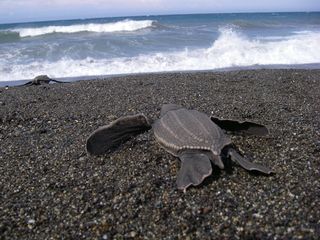How Do I Continue Hajal s Quest After the Turtle
Pacific Leatherback Turtles' Alarming Decline Continues

The Pacific leatherback turtle's last population stronghold could disappear within 20 years if conservation efforts aren't expanded, a new study finds.
Most of the Pacific Ocean's leatherback turtles, at least 75 percent, lay their eggs at Bird's Head Peninsula in Papua Barat, Indonesia. The number of leatherback turtle nests at the peninsula's beaches dropped 78 percent between 1984 and 2011, the study discovered.
"If the decline continues, within 20 years it will be difficult if not impossible for the leatherback to avoid extinction," Thane Wibbels, a biologist at the University of Alabama at Birmingham (UAB), said in a statement. "That means the number of turtles would be so low that the species could not make a comeback."
At Jamursba Medi Beach, on Bird's Head Peninsula, nests fell from 14,455 in 1984 to a low of 1,532 in 2011, the study found. Because female turtles nest multiple times each year, the researchers estimate that 489 breeding females remain in the western Pacific leatherback population. Overall, the total turtle population dropped 5.9 percent each year since 1984, the researchers estimate. [In Images: Tagging & Tracking Sea Turtles]
The findings were published today (Feb. 27) in the journal Ecospheres.
Reasons for the decline
Leatherback sea turtles are the largest of all living turtles and are found throughout the world's oceans. Their unique "leathery" shells can reach 6.5 feet (2 meters) in length and they weigh up to 1,190 pounds (540 kilograms).
Although Atlantic populations have increased in recent years, the Pacific leatherback population has dropped more than 95 percent since the 1980s. The leatherback turtle was listed as endangered in the United States in 1970.
Much of the decline is due to humans. Before the practice was outlawed in 1993, villagers and fisherman collected turtle eggs by the thousands in Indonesia. Dogs and pigs still dig up turtle eggs along Bird's Head's beaches, Ricardo Tapilatu, lead study author and a doctoral student at UAB, said in a statement.
In the ocean, turtles are often victims of bycatch, unintentional netting and killing while fishing for other prey, as they travel through multiple fishing zones on their long migrations. Pacific leatherback turtles migrate from their nesting site in Indonesia to feeding grounds near the Americas.
Environmental changes caused by the El Niño/La Niña climate oscillation may also have affected turtles by reducing their food sources, particularly jellyfish.
More conservation needed
Conservation efforts at Indonesia's beaches include patrols by local residents to protect nests from predators and relocating eggs to areas with cooler sand. (The sand temperature influences the sex of hatchlings — cool sand means more male turtles.)
But Tapilatu, a native of western Papua, Indonesia, who has worked on turtle conservation since 2004, said beach conservation alone is unlikely to tip the scales in favor of the recovery.
"They can migrate more than 7,000 miles [11,000 kilometers] and travel through the territory of at least 20 countries, so this is a complex international problem," Tapilatu said.
In February 2012, the United States protected about 42,000 square miles (108,800 square kilometers) of the Pacific Ocean off California, Oregon and Washington as critical habitat for leatherbacks.
Reach Becky Oskin at boskin@techmedianetwork.com. Follow her on Twitter @beckyoskin. Follow OurAmazingPlanet on Twitter @OAPlanet. We're also on Facebookand Google+.
Source: https://www.livescience.com/27519-pacific-leatherback-turtle-decline.html
0 Response to "How Do I Continue Hajal s Quest After the Turtle"
Post a Comment